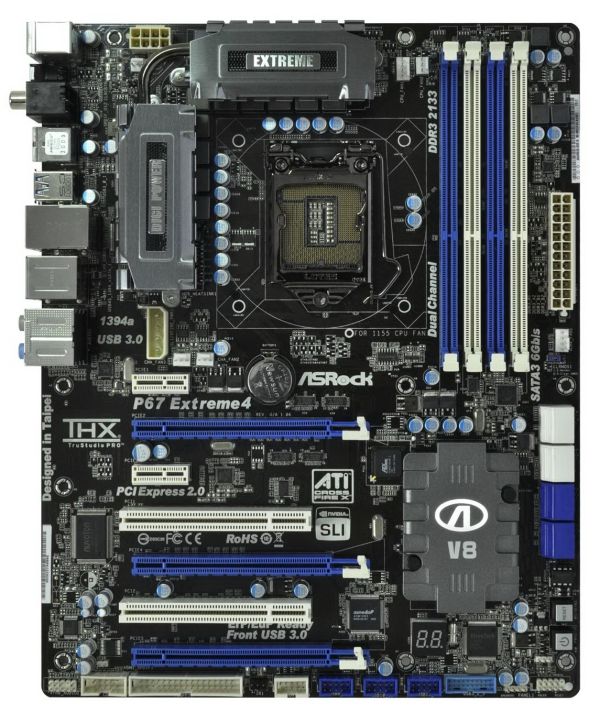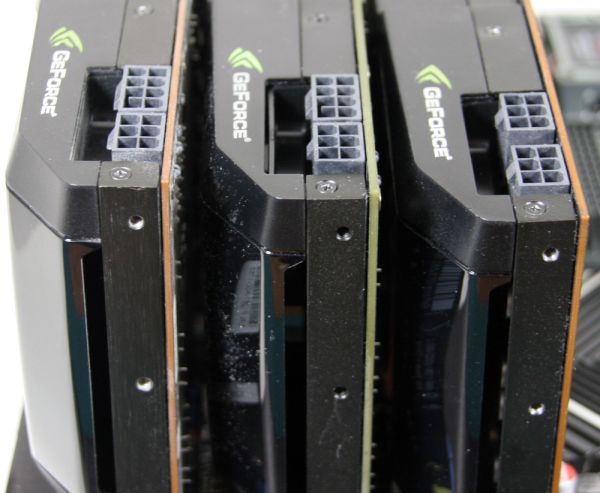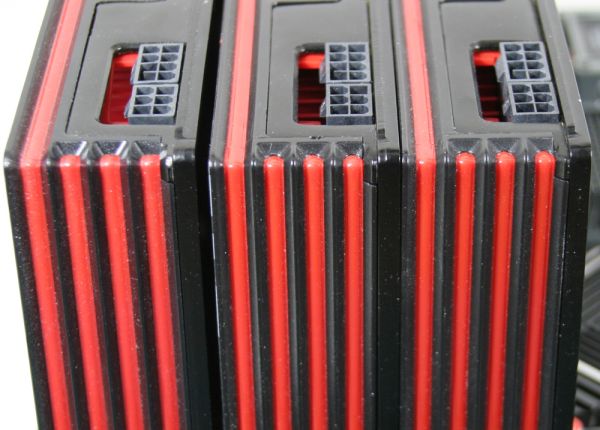A Look At Triple-GPU Performance And Multi-GPU Scaling, Part 1
by Ryan Smith on April 3, 2011 7:00 AM ESTFitting Three Video Cards in an ATX Case
I thought we’d flip our normal GPU review style on its head by starting with Power, Temperature, and Noise first. NVIDIA and AMD have both long recommended against placing high-end video cards directly next to each other, in favor of additional spacing between video cards. Indeed this is a requirement for their latest dual-GPU cards, as both the GTX 590 and 6990 draw relatively massive amounts of air using a fan mounted at the center of the card and exhaust roughly half their air inside of the case. Their reference style single-GPU cards on the other hand are fully exhausting with fans mounted towards the rear of the card. Thus multi-GPU configurations with the cards next to each other is supposed to be possible, though not ideal.
There’s a reason I want to bring this up first, and a picture is worth a thousand words.
While AMD and NVIDIA’s designs share a lot in common – a rear-mounted blower fan pushes air over a vapor chamber cooler – the shrouds and other external equipment are quite different. It’s not until we see a picture that we can appreciate just how different they are.
With the Radeon HD 6000 series, AMD’s reference designs took on a very boxy design. The cards fully live up to the idea of a “black box”; they’re enclosed on all sides with a boxy cooler and a black metal backplate. As a GPU reviewer I happen to like this design as the GPUs are easy to stack/store, and the backplate covers what would normally be the only exposed electronics on the card. The issue with this boxy design is that AMD is taking full advantage of the PCIe specification, leading to the 6900 series being the full width allowed.
NVIDIA on the other hand has always had some kind of curve in their design, normally resulting in a slightly recessed shroud around the blower intake. For the GTX 580 and GTX 570 they took a further step in recessing the shroud around this area, leading to the distinct wedge shape. At the same time NVIDIA does not use a backplate, saving precious millimeters of space. The end result of this is that even when packed like sardines, the GTX 580 and GTX 570 blowers have some space reserved for air intake.
The Radeon HD 6970 does not, and this is our problem. The picture of the 6970 in triple-CF really paints the picture, as the middle card is directly pressed up against the top card. Because these cards are so large and heavy the rear ends tend to shift and dip some when installed against a vertical motherboard – in fact this is why we can normally get away with a dense dual-CF setup since the bottom card dips a bit more – but in a triple-CF configuration the end result is that one of the cards will end up getting up-close and personal with another one.
Without outside intervention this isn’t usable. We hit 99C on the middle card in Crysis when we initially installed the three cards, and Crysis isn’t the hardest thing we run. For the purposes of our test we ultimately resorted to wedging some space between the cards with wads of paper, but this isn’t a viable long-term solution.
Unfortunately long-term alternatives are few if you want to give a triple-GPU setup more space. Our testbed uses an Asus Rampage II Extreme, which features three PCIe slots mixed among a total of 6 slots; the way it’s laid out makes it impossible to have our triple-GPU configuration setup in any other manner. Even something like the ASRock P67 Extreme4 can’t escape the fact that the ATX spec only has room for 7 slots and that when manufacturers actually use the 7th and topmost slot that it’s a short PCIe x1 slot. In short you won’t find an ATX motherboard that can fit three video cards and at the same time gives each one a slot’s worth of breathing room. For that you have to use a larger than ATX form factor.

So what’s the point of all of this rambling? With AMD’s current shroud design it’s just not practical to do triple-CF on air on an ATX motherboard. If you want to play with three AMD boards you need to think outside of the box: either use water cooling or use a larger motherboard.












97 Comments
View All Comments
marc1000 - Monday, April 4, 2011 - link
Ryan, if at all possible, please include a reference card for the "low-point" of performance. We rarely see good tests with mainstream cards, only the top tier ones.So if you can, please include a radeon-5770 or GTX460 - 2 of these cards should have the same performance as one of the big ones, so it would be nice to see how well they work by now.
Ryan Smith - Wednesday, April 6, 2011 - link
These charts were specifically cut short as the focus was on multi-GPU configurations, and so that I could fit more charts on a page. The tests are the same tests we always run, so Bench or a recent article ( http://www.anandtech.com/show/4260/amds-radeon-hd-... ) is always your best buddy.Arbie - Monday, April 4, 2011 - link
Looking at your results, it seems that at least 99.9% of gaming enthusiasts would need nothing more than a single HD 6970. Never mind the wider population of PC-centric folk who read Anandtech.More importantly, this isn't going to change for several years. PC game graphics are now bounded by console capabilities, and those advance only glacially. In general, gamers with an HD 6850 (not a typo) or better will have no compelling reason to upgrade until around 2014! I'm very sad to say that, but think it's true.
Of course there is some technical interest in how many more FPS this or that competing architecture can manage, but most of that is a holdover from previous years when these things actually mattered on your desktop. I'm not going to spend $900 to pack two giant cooling and noise problems into my PC for no perceptible benefit. Nor will anyone else, statistically speaking.
The harm in producing such reports is that it spreads the idea that these multi-board configurations still matter. So every high-end motherboard that I consider for my next build packs in slots for two or even three graphics boards, and an NF-200 chip to make sure that third card (!) gets enough bandwidth. The mobos are bigger, hotter, and more expensive than they need to be, and often leave out stuff I would much rather have. Look at the Gigabyte P67A-UD7, for example. Full accommodation for pointless graphics overkill (praised in reviews), but *no* chassis fan controls (too mundane for reviewers to mention).
I'd rather see Anandtech spend time on detailed high-end motherboard comparisons (eg. Asus Maximus IV vs. others) and components that can actually improve my enthusiast PC experience. Sadly, right now that seems to be limited to SSDs and you already try hard on those. Are we reduced to... fan controllers?
Thanks,
Arbie
erple2 - Tuesday, April 5, 2011 - link
There are still several games that are not Console Ports (or destined to be ported to a console) that are still interesting to read about and subsequently benchmark. People will continue to complain that PC Gaming has been a steady stream of Console Ports, just like they have been since the PSX came out in late '95. The reality is that PC Gaming isn't dead, and probably won't die for a long while. While it may be true that EA and company generate most of their revenue from lame console rehash after lame console rehash, and therefore focus almost single-mindedly on that endeavor, there are plenty of other game publishers that aren't following that trend, thereby continuing to make PC Gaming relevant.The last several tests I've seen of Motherboard reviews has more or less convinced me that they just don't matter at all any more. Most (if not all) motherboards of a given chipset don't offer anything performance wise over other competing motherboards.
There are nice features here and there (Additional Fan Headers, more USB ports, more SATA Ports), but on the whole, there's nothing significant to differentiate one Motherboard from another, at least from a performance perspective.
789427 - Monday, April 4, 2011 - link
I would have thought that someone would pay attention to if throttling was occurring on any of the cards due to thermal overload.The reason is that due to differences in ventilation in the case, layout and physical card package, you'll have throttling at different times.
e.g. if the room was at a stinking hot 50C, the more aggressive the throttling,the greater the disadvantage to the card.
Conversely, operating the cards at -5C would provide a huge advantage to the card with the worst heat/fan efficiency ratio.
cb
TareX - Monday, April 4, 2011 - link
I'm starting to think it's really getting less and less compelling to be a PC gamer, with all the good games coming out for consoles exclusively.Thank goodness for Arkham Asylum.
Golgatha - Monday, April 4, 2011 - link
I'd like to see some power, heat, and PPD numbers for running Folding@Home on all these GPUs.Ryan Smith - Monday, April 4, 2011 - link
The last time I checked, F@H did not having a modern Radeon client. If they did we'd be using it much more frequently.karndog - Monday, April 4, 2011 - link
Cmon man, you have an enthusiast rig with $1000 worth of video cards yet you use a stock i7 at 3.3ghz??"As we normally turn to Crysis as our first benchmark it ends up being quite amusing when we have a rather exact tie on our hands."
Ummm probably because your CPU limited! Update to even a 2500k at 4.5ghz and i bet you'll see the Crossfire setup pull away from the SLI.
karndog - Monday, April 4, 2011 - link
Not trying to make fun of your test rig, if that's all you have access too. Im just saying that people who are thinking about buying the Tri SLI / Xfire video card setups reviewed here arent running their CPU at stock clock speeds, especially such low ones, which skew the results shown here.